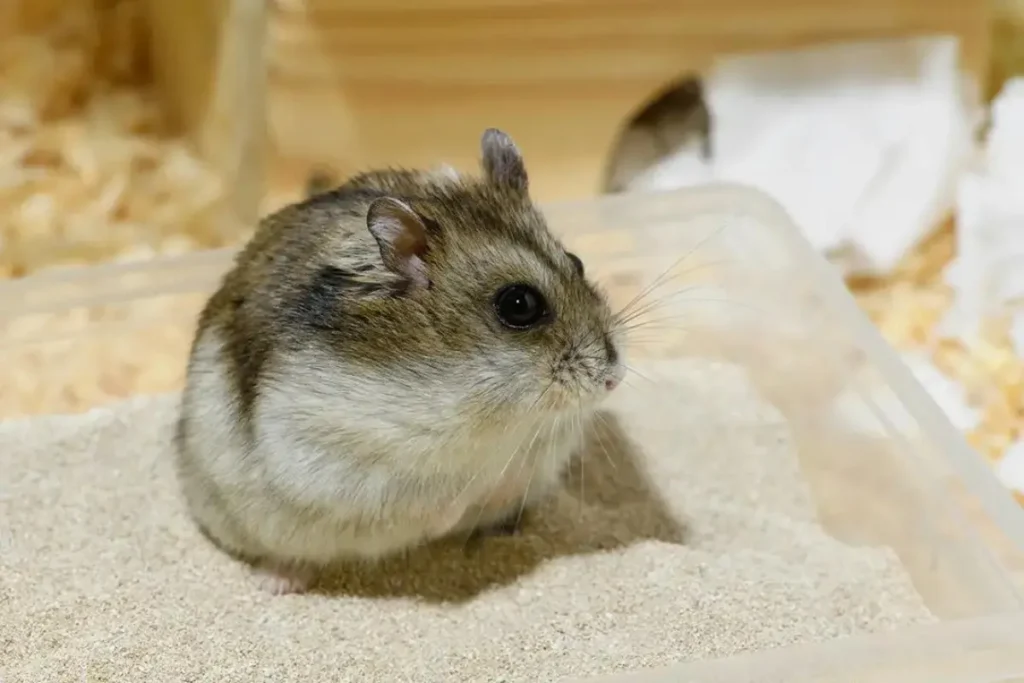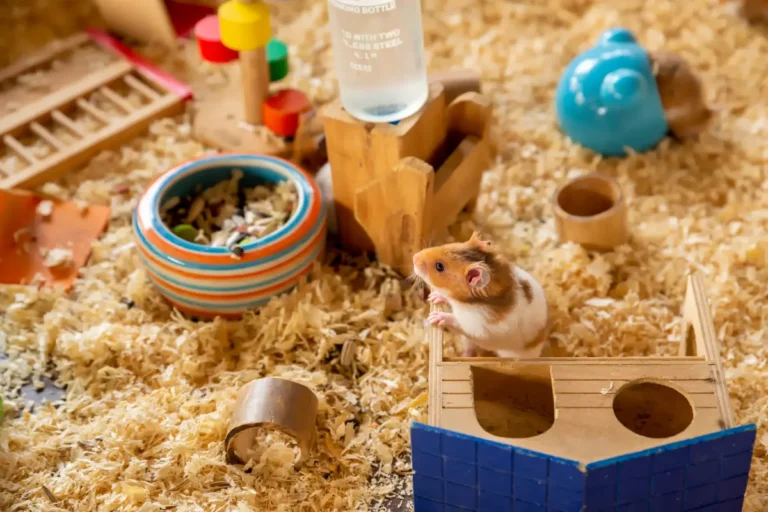How Does a Sand Bath Work for Hamsters?
Hamsters are adorable, low-maintenance pets with specific needs to stay healthy and happy. One of these needs is a sand bath, an essential grooming and enrichment tool that mimics their natural cleaning habits.
Why Do Hamsters Need Sand Baths?
Unlike dogs and other pets, hamsters cannot be bathed in water. Water baths can damage their coats and make them more prone to skin issues. Instead, sand baths are a perfect way for hamsters to get rid of excess oils, dirt, and keep their fur clean without harming their skin or coat. Sand baths also give hamsters a chance to dig, roll, and enjoy some natural grooming, which is a big part of their behavior in the wild.
Key Benefits of Sand Baths
- Oil Regulation: Hamsters naturally produce oils to protect their fur and skin, but too much oil can make their coat greasy. Sand acts as a natural dry shampoo, soaking up excess oils and keeping their coat fluffy.
- Exfoliation: Sand grains gently exfoliate the hamster’s skin, removing dead cells and grime, which prevents skin irritation and keeps the coat healthy.
- Parasite Deterrence: Sand baths help create an environment less welcoming to parasites like mites, contributing to overall health.
- Mental Enrichment: Digging, rolling, and burrowing in sand provides mental stimulation, allowing hamsters to enjoy their natural behaviors.

Sand Bath vs. Water Bath for Hamsters
While water baths might seem like a good cleaning option, they can be highly stressful and even dangerous for hamsters. Here’s a quick comparison:
Sand Bath:
- Natural Grooming: Mimics the hamster’s instinctive grooming method, safely removing dirt and oils without causing stress.
- Preserves Natural Oils: Maintains essential skin and fur oils, avoiding the dryness that water can cause.
- Provides Stimulation: Sand baths are also a source of enrichment, as hamsters enjoy digging and rolling.
- Odor Control: Sand absorbs odors and moisture, keeping your hamster’s fur fresh.
Water Bath:
- Stressful: Hamsters are unfamiliar with water in large quantities, making water baths highly stressful.
- Risk of Hypothermia: Water baths can cause severe chilling and even hypothermia, especially since hamsters are sensitive to temperature drops.
- Oil Stripping: Water can strip away protective oils, leading to dry, irritated skin.
- Respiratory Risk: Exposure to water and damp fur can cause respiratory problems.
When to Consider a Water Bath
Only consider a water bath in extreme circumstances, such as a veterinary recommendation for a specific condition, or if a sticky substance that cannot be removed with sand or gentle wiping gets onto your hamster’s fur.
Types of Sand to Use for Hamsters
When choosing sand for your hamster’s bath, not all sand is created equal. Some types of sand, especially dust or powder-like sand, can be dangerous as they may cause respiratory issues. Always avoid anything labeled as “dust” or “powder,” as these fine particles can irritate your hamster’s lungs and lead to serious health problems.
Here are a few of the best sand options for hamster sand baths:
1. Children’s Play Sand
Children’s play sand is an affordable and easy-to-find option. You can purchase it at most hardware stores, and it works well for hamsters. Before using this sand, check if it’s labeled as heat-treated. If it is, it’s already safe to use. If not, you can sanitize it yourself by baking it at 350°F (175°C) for about 20 minutes to kill any bacteria or fungus.
- Tip: Play sand can have rougher pieces, so it’s a good idea to sift through it before using it in your hamster’s bath. This can help remove any larger, jagged pieces that might irritate your hamster’s skin.
2. Reptile Sand
Reptile sand, typically sold in pet stores, is another popular option for hamsters. It’s softer than play sand, which makes it gentler on your hamster’s skin. The downside is that it tends to be more expensive and comes in smaller quantities.
When choosing reptile sand, make sure it meets these criteria:
- No Added Minerals or Calcium: Calcium in sand can lead to impaction, which is harmful to hamsters.
- All-Natural: Avoid sand that’s dyed or treated with chemicals.
3. Chinchilla Bath Sand
Chinchilla bath sand is specifically made for small animals, but it isn’t always the best choice for hamsters. Some brands, like Kaytee, have been criticized for being too dusty, which can cause respiratory issues for your hamster.
Another issue with chinchilla bath sand is the price. A small bag often costs more than other types of sand, which can add up over time. However, if you opt for chinchilla sand, check that it’s free from dust and suitable for your hamster’s use.
Setting Up the Sand Bath for Your Hamster
Hamsters find sand baths not just useful for grooming but also enjoyable! They often dig, roll, and bury themselves in the sand, which provides mental and physical stimulation. Syrian hamsters tend to dig in their sand baths, while dwarf hamsters may prefer rolling around.
Here’s how to do it step-by-step:
1. Choose a Large Container
The first step in setting up a sand bath is choosing the right container. Hamsters are active and need room to move around. Avoid small, cramped containers, as they won’t have enough space to roll and dig. A large, shallow dish or plastic storage container works best. The ideal size should be wide enough to let your hamster stretch and move freely while using the bath.
Some popular options include:
- Shallow plastic bins (you can find these in most dollar stores)
- Flat plastic trays or dishes
- Even an old baking pan or box could work, as long as it’s low enough for your hamster to easily climb in and out.
2. Add the Sand
Once you have a suitable container, the next step is to fill it with the sand. Fill the container about 1 to 2 inches deep. Too much sand can make it difficult for your hamster to dig comfortably, while too little sand won’t give them the space they need to roll around.
When choosing sand, ensure it is safe for hamsters (i.e., dust-free and without harmful additives like dyes or calcium). You can opt for children’s play sand, reptile sand, or chinchilla bath sand, but make sure the sand is appropriate for hamster use, as we discussed earlier.
3. Provide a Hideout or Tunnel
Hamsters like to feel secure when bathing, so adding a hideout or tunnel to the sand bath can make them feel more comfortable. A small cardboard tunnel, a plastic hideaway, or a piece of a paper towel roll can work great. The hideout allows your hamster to retreat and feel safe, while still being able to explore and dig around the sand.
4. Place the Sand Bath in the Cage
Once you’ve set up the sand bath, place it in your hamster’s cage. Ideally, place the sand bath somewhere they can easily access, but not in a high-traffic area of the cage. Hamsters tend to prefer privacy when bathing, so placing it in a quiet corner or near their food and water bowl can encourage them to use it.
You can make the sand bath even more fun by hiding small treats or bits of food in the sand. This encourages your hamster to forage and use their sense of smell, which adds an extra layer of enrichment to their routine.

5. Regular Cleaning and Maintenance
It’s important to keep the sand clean and fresh for your hamster. You can leave the sand bath in their cage 24/7, but make sure to sift through the sand regularly to remove any waste (such as pee or poop) and debris. A small sifter or mesh strainer is a great tool for this. Make sure to clean the entire bath at least once a week to keep it hygienic.
6. Monitor Usage
It’s always a good idea to observe how your hamster interacts with their sand bath. Some hamsters might take to it immediately, while others might need some time to get used to it. If your hamster seems unsure, gently place them in the bath to show them it’s safe. Most hamsters enjoy sand baths once they realize how fun and relaxing they can be!
Hamster Species and Their Sand Bath Preferences
Each hamster species has different sand bath needs due to their natural habitats. While some hamsters may benefit from daily access to a sand bath, others may only need it a few times per week. Here’s a general guideline:
- Syrian Hamsters: Moderate need—1–2 times per week.
- Dwarf Campbell Russian and Winter White Russian Hamsters: High need—daily or near-daily access.
- Roborovski Hamsters: Very high need—constant access if possible.
- Chinese Hamsters: Moderate to high need—2–3 times per week.
| Species | Need for Sand Bath | Recommended Frequency | Habitat |
|---|---|---|---|
| Syrian Hamster | Moderate | 1–2 times per week | Semi-arid regions |
| Dwarf Campbell Russian Hamster | High | Daily access | Arid steppes |
| Dwarf Winter White Russian | High | Daily access | Cold, dry steppes |
| Roborovski Dwarf Hamster | Very High | Constant access | Desert regions |
| Chinese Hamster | Moderate to High | 2–3 times per week | Desert edges and grasslands |
Important Considerations
While sand baths are a fun and necessary part of hamster care, there are a few things to be mindful of:
- Avoid Overuse: Providing sand baths too frequently can dry out your hamster’s skin. Once or twice a week is generally sufficient.
- Monitor Your Hamster’s Behavior: Not all hamsters enjoy sand baths right away. If your hamster doesn’t seem interested, try adding a hideout or cover to make the experience feel safer and more natural.
- Hygiene: Always clean the sand before use. Ensure that no chemicals, scents, or additives are present, as these can harm your hamster.
In conclusion, a sand bath is a simple but essential addition to your hamster’s care routine, offering benefits for their skin, fur, and mental stimulation.
With the right sand, a safe container, and mindful frequency, you can ensure your hamster’s sand bathing experience is both enjoyable and beneficial.






